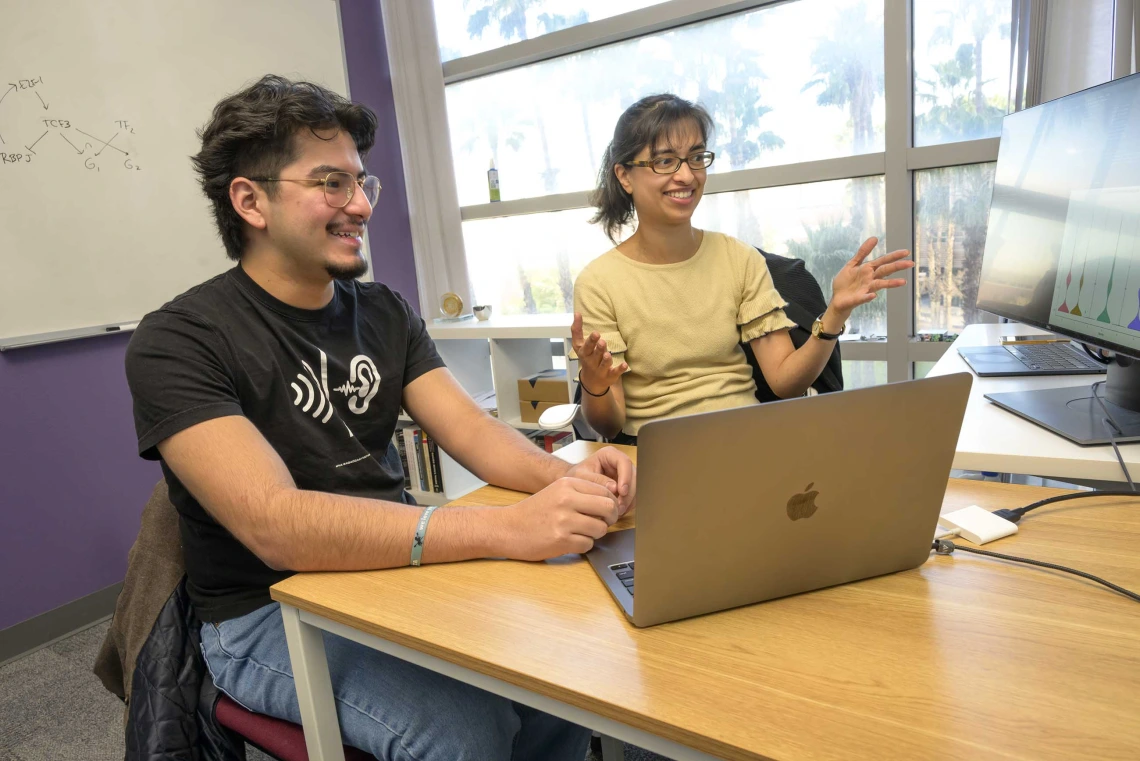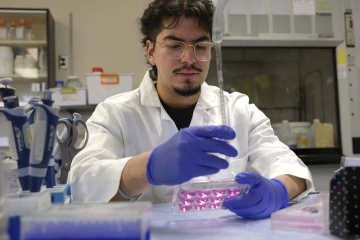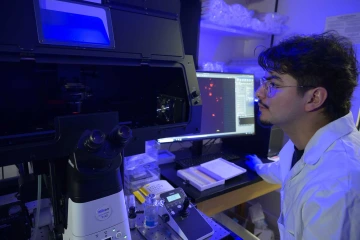Catching PHIRE: Students harness informatics, ignite research careers
The Place-based Health Informatics Research Education program allows students to kick-start their research careers with mentorships and paid research opportunities.

(From left) Waldo Guzman Barrientos is taking part in the Place-based Health Informatics Research Education program, with Megha Padi, PhD, an assistant professor at the University of Arizona College of Medicine – Tucson’s Department of Cellular and Molecular Medicine.
Photo by Kris Hanning, U of A Health Sciences Office of Communications
Waldo Guzman Barrientos felt like he was sputtering after he finished his first year of his college in Chicago. He decided to transfer to the University of Arizona in 2022 to be closer to his family, which he says is the wisest decision of his young career.
At the U of A Health Sciences, Guzman Barrientos found the Place-based Health Informatics Research Education program. PHIRE – pronounced “fire” – is an undergraduate research training program will help him fulfill his dreams of using data science to conduct biological research, earning a doctorate in systems biology and, one day, running his own research laboratory.

Vignesh Subbian, PhD, associate director of health data sciences and research at the University of Arizona Center for Biomedical Informatics and Biostatistics, is program director of Place-based Health Informatics Research Education, or PHIRE.
Photo by Kris Hanning, U of A Health Sciences Office of Communications
“I would love to one day help students as much as my mentors have helped me,” said Guzman Barrientos, who is on track graduate in May with a bachelor’s degree double majoring in computer science and molecular biology. “PHIRE has really made me sure that research is what I want to do and provided resources to help make me feel more prepared to go down that path.”
Kindling focus through PHIRE
PHIRE is one of the educational offerings within the Center for Biomedical Informatics and Biostatistics at the U of A Health Sciences. The research training initiative prepares undergraduate students for biomedical research careers through mentored research projects that address close-to-home health, environmental and engineering issues.
Vignesh Subbian, PhD, the associate director of health data sciences and research at the Center for Biomedical Informatics and Biostatistics, said the program was conceived in a conversation with PHIRE co-director Kacey Ernst, PhD, MPH, a professor at the Mel and Enid Zuckerman College of Public Health and BIO5 Institute member. PHIRE was born out of their desire to help undergraduates become involved in the growing field of health informatics and funded by a grant from the National Library of Medicine, a division of the National Institutes of Health.
“One of the things that drives and motivates me within the Center for Biomedical Informatics and Biostatistics and being involved with PHIRE is to bring people together across different disciplines to take on complex biomedical problems and questions,” said Subbian, who is an associate professor at the U of A College of Engineering and a member of the BIO5 Institute. “We look at ways to foster better interactions and collaborations between human investigators and technologies through informatics.”
Students work on their research full time for 12 weeks over the summer and part time during the fall semester. Upon graduation, their degree includes a specialization in health informatics in addition to their chosen major. The 2024 cohort of PHIRE scholars includes U of A students from the College of Science, Zuckerman College of Public Health, College of Engineering, and College of Agriculture, Life and Environmental Sciences.

As part of his research, Guzman Barrientos analyzes cancer cells in a wet lab.
Photo by Kris Hanning, U of A Health Sciences Office of Communications
“In informatics lingo, we feel there are different PHIRE phenotypes, meaning there is no single ideal PHIRE scholar,” Subbian said. “But I would say a typical PHIRE scholar is someone who can seamlessly walk across different disciplinary boundaries. They make connections and work very intuitively, and they can take informatics concepts and apply them to their work. We have scholars working on questions related to range of domains from Merkel cell carcinoma and aging to fungal pathogens and lung microbiomes. ”
Guzman Barrientos learned about PHIRE through the university’s Undergraduate Biology Research Program. Hundreds of undergraduate students learn about and participate in research through UBRP, which represents a natural pool of students who might be interested in participating in PHIRE. Through PHIRE, students learn professional skills in addition to scientific concepts.
Guzman Barrientos was paired with faculty mentor Megha Padi, PhD, an assistant professor at the U of A College of Science’s Department of Molecular and Cellular Biology. Padi helped Guzman Barrientos shape his research goals and apply his informatics background to cancer research in a project that has now become the focus of his educational career.
“PHIRE really helps students find their focus,” Padi said. “We have talented students who have programming experience, and they come through my lab and become interested in the work we do. A lot of students are interested in public health, and they want to do good for others. Others want to go into industry. I think a program like PHIRE is incredibly important to give them these opportunities.”
Supporting a dynamic team
Guzman Barrientos had been working with Padi for a year before they were paired through PHIRE. Padi helped introduce Guzman Barrientos to bioinformatics, which is the science of processing and analyzing data to provide insight into biology and medicine for the good of society at large. Today, he applies informatics to their research collaboration, “Boolean network modeling of lineage plasticity in Merkel cell carcinoma,” which attempts to find out why some cancers are resistant to drugs and how that resistance can be overcome.
“Waldo has played a big role in shaping the project,” Padi said. “He’s doing the quantitative modeling that will show exactly how these cells are changing their cell type as the cancer spreads. Ultimately, his models will help predict which drugs are more effective in treating cancer.”

Guzman Barrientos conducts computer modeling and analyzes data in a dry lab.
Photo by Kris Hanning, U of A Health Sciences Office of Communications
Guzman Barrientos conducts computer modeling and analyzes data in a dry lab, but he also examines and analyzes cancer cells through a microscope in a wet lab. He said he enjoys learning from and working with Padi, who helps him sharpen his ideas and come up with new avenues to explore.
“Dr. Padi has been wonderful,” Guzman Barrientos said. “I want to do something where I’m able to evenly split my time between wet lab work and computational, dry lab work. I’m looking to get into bioengineering or molecular biology. Dr. Padi has helped me make that connection, and I feel like I know where I want to go and how to get there.”
Padi has also been instrumental in giving him professional advice, including selecting classes and programs and fusing his academic strengths with his professional interests in a way that could lead to a lifelong career.
Fueled by his experience in PHIRE, Guzman Barrientos is eager to take the next steps in his academic and professional career.
“PHIRE gave me the opportunity to do research full time, which I wouldn’t have been able to do otherwise. This helped me be sure that doing research is something I enjoy and would be interested in doing for my career. It also has allowed me to make considerable progress, and now I’m on my way to having my first publication.”
Guzman Barrientos is also looking ahead to graduate school. He hopes to continue the research he is working on now as his thesis as he pursues a Master of Science in Molecular and Cellular Biology, which he plans to complete in 2026.
Experts
Vignesh Subbian, PhD
Associate Professor, University of Arizona College of Engineering
Associate Director, Health Data Sciences and Research, Center for Biomedical Informatics and Biostatistics, U of A Health Sciences
Member, BIO5 Institute
Megha Padi, PhD
Assistant Professor, Department of Molecular and Cellular Biology, College of Science
Assistant Professor, Department of Cellular and Molecular Medicine, College of Medicine – Tucson
Contact
Phil Villarreal
U of A Health Sciences Office of Communications
520-403-1986, pvillarreal@arizona.edu

